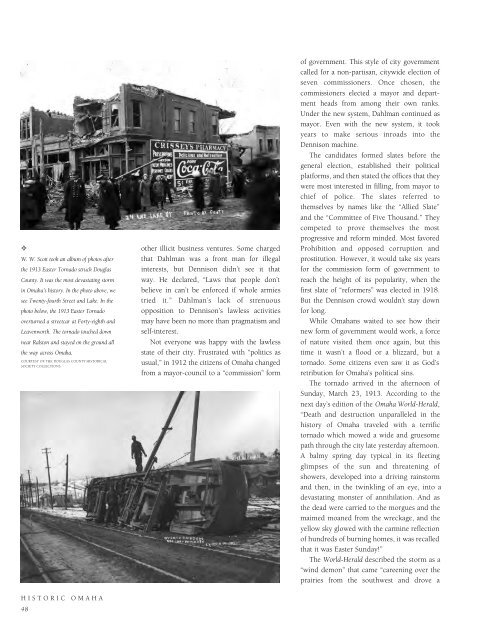Historic Omaha
An illustrated history of Omaha and the Douglas County area, paired with the histories of companies, families and organizations that make the region great.
An illustrated history of Omaha and the Douglas County area, paired with the histories of companies, families and organizations that make the region great.
Create successful ePaper yourself
Turn your PDF publications into a flip-book with our unique Google optimized e-Paper software.
✧<br />
W. W. Scott took an album of photos after<br />
the 1913 Easter Tornado struck Douglas<br />
County. It was the most devastating storm<br />
in <strong>Omaha</strong>’s history. In the photo above, we<br />
see Twenty-fourth Street and Lake. In the<br />
photo below, the 1913 Easter Tornado<br />
overturned a streetcar at Forty-eighth and<br />
Leavenworth. The tornado touched down<br />
near Ralston and stayed on the ground all<br />
the way across <strong>Omaha</strong>.<br />
COURTESY OF THE DOUGLAS COUNTY HISTORICAL<br />
SOCIETY COLLECTIONS.<br />
other illicit business ventures. Some charged<br />
that Dahlman was a front man for illegal<br />
interests, but Dennison didn’t see it that<br />
way. He declared, “Laws that people don’t<br />
believe in can’t be enforced if whole armies<br />
tried it.” Dahlman’s lack of strenuous<br />
opposition to Dennison’s lawless activities<br />
may have been no more than pragmatism and<br />
self-interest.<br />
Not everyone was happy with the lawless<br />
state of their city. Frustrated with “politics as<br />
usual,” in 1912 the citizens of <strong>Omaha</strong> changed<br />
from a mayor-council to a “commission” form<br />
of government. This style of city government<br />
called for a non-partisan, citywide election of<br />
seven commissioners. Once chosen, the<br />
commissioners elected a mayor and department<br />
heads from among their own ranks.<br />
Under the new system, Dahlman continued as<br />
mayor. Even with the new system, it took<br />
years to make serious inroads into the<br />
Dennison machine.<br />
The candidates formed slates before the<br />
general election, established their political<br />
platforms, and then stated the offices that they<br />
were most interested in filling, from mayor to<br />
chief of police. The slates referred to<br />
themselves by names like the “Allied Slate”<br />
and the “Committee of Five Thousand.” They<br />
competed to prove themselves the most<br />
progressive and reform minded. Most favored<br />
Prohibition and opposed corruption and<br />
prostitution. However, it would take six years<br />
for the commission form of government to<br />
reach the height of its popularity, when the<br />
first slate of “reformers” was elected in 1918.<br />
But the Dennison crowd wouldn’t stay down<br />
for long.<br />
While <strong>Omaha</strong>ns waited to see how their<br />
new form of government would work, a force<br />
of nature visited them once again, but this<br />
time it wasn’t a flood or a blizzard, but a<br />
tornado. Some citizens even saw it as God’s<br />
retribution for <strong>Omaha</strong>’s political sins.<br />
The tornado arrived in the afternoon of<br />
Sunday, March 23, 1913. According to the<br />
next day’s edition of the <strong>Omaha</strong> World-Herald,<br />
“Death and destruction unparalleled in the<br />
history of <strong>Omaha</strong> traveled with a terrific<br />
tornado which mowed a wide and gruesome<br />
path through the city late yesterday afternoon.<br />
A balmy spring day typical in its fleeting<br />
glimpses of the sun and threatening of<br />
showers, developed into a driving rainstorm<br />
and then, in the twinkling of an eye, into a<br />
devastating monster of annihilation. And as<br />
the dead were carried to the morgues and the<br />
maimed moaned from the wreckage, and the<br />
yellow sky glowed with the carmine reflection<br />
of hundreds of burning homes, it was recalled<br />
that it was Easter Sunday!”<br />
The World-Herald described the storm as a<br />
“wind demon” that came “careening over the<br />
prairies from the southwest and drove a<br />
HISTORIC OMAHA<br />
48
















